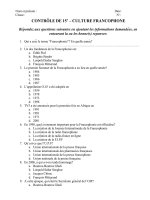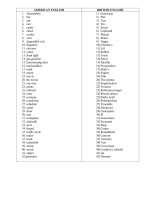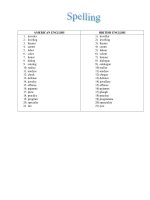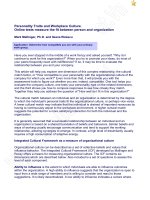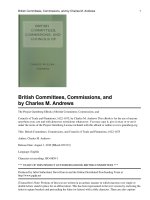BRITISH CULTURE ppsx
Bạn đang xem bản rút gọn của tài liệu. Xem và tải ngay bản đầy đủ của tài liệu tại đây (2.23 MB, 66 trang )
Welcome to our presentation!
BRITISH CULTURE
Group 7: Lê Thị Soan Dương
Nguyễn Thị Hoài Hương
Phan Thị Hoàng Diễm
Trương Thị Nữ
Phan Thị Minh Thương
Lê Thị Vân
THE GOVERNMENT
OUTLINE
I. Introduction
II. Body
1. The Cabinet
2. The Prime Minister
3. Ministries & Departments
4. Local Government
5. Three parties
III. Conclusion
THE CABINET
About 20
ministers
Chosen by the
Prime Minister
Include departmental
& non-departmental
ministers
The Prime
Minister
Functions
- To initiate & decide
on policy
- The supreme control of
government
- The co-ordination of
government departments
CABINET MEETINGS
o
The Cabinet meets once a week in
private and its proceedings are
confidential
o
Reports are made of the meetings
and circulated to government
departments
CABINET MEETINGS
o
They summarize the topics discussed
and decisions taken but they never
refer to individuals or what they said
o
After 30 years Cabinet papers may be
made available for inspection in the
Public Record Office at Kew, Surrey
CABINET OFFICE
Functions
- Running a busy
communication network
- Keeping ministers in touch
with each other
- Drawing up the agendas
for cabinet meetings
CABINET OFFICE
o
It also does the same things for cabinet
committees
These committees are appointed by the
cabinet to look into various matters in
more detail than the individual member of
the cabinet have time (or knowledge) for
Unlike members of “the government”
itself, the people on these committees are
not necessarity politicians
Who is British Prime minister?
Prime
ministers
Member of either the
Commons or Lords
Leader of a great
political party
Inherited a majority
in the Commons
Authority
the highest political authority in the United
Kingdom
leader a major political party
commands a majority in the House of
Commons (the lower house of the Legislature
the leader of the Cabinet (the Executive)
Under the British system, there is a unity of
powers rather than separation.
Authority
In the House of Commons
guides the law-making process with the goal of
enacting the legislative agenda of the political
party.
In his executive capacity
appoints (and may dismiss) all other cabinet
members and ministers.
co-ordinates the policies, activities of all
government departments, the staff of the Civil
Service (Senior civil servants, bishops and judges)
Authority
The PM acts as the public "face" and "voice" of Her
Majesty's Government, both at home and abroad.
the dissolution of Parliament; high judicial, political,
official and Church of England appointments.
the conferral of peerages, knighthoods, decorations
and other honors.
making the final decisions on major issues (the Euro
or whether Britain should join a potential American
attack on Iraq.
Authority
The PM chairs a number of select committees
(the Defence and Overseas Policy committee,
the Constitutional Reform Committee, the
Intelligence Services Committee … )
The PM appears before the House of
Commons and must answer questions put to
him or her by the MP everyday.
Where does the Prime Minister live?
Traditionally, the official residence of the Prime
Minister is at Number 10 Downing Street.
PM also has a house in the country called Chequers.
What is Chequers?
+ a country house belonging to the Government,
located on Buckinghamshire, the south of UK.
+ hold a private conference of some of his Ministers
or receive foreign visitors over a weekend.
+ entertain guests as a special privilege.
No 10 Downing Street
chequers
In the 2010 general election no single party won
enough majority of seats to form the government
alone. So, to form a government two or more
parties had to join together.
David Cameron, the leader of the Conservative
Party, formed a new government, in coalition with
the Liberal Democrats.
David Cameron - leader of the Conservative Party
Nick Clegg - leader of the Liberal Democrats
Vietnamese Prime Minister
the head of the executive branch of the
Vietnamese government.
presides over the Vietnamese cabinet, and is
responsible for appointing and supervising
ministers.
appointed by the President from among the
members of the National Assembly.
Prime Minister of Vietnam is not necessarily a
member of parliament.
3. Ministries/ Departments
and the Civil Service
3.1 Introduction ministries/ departments
3.2 Types of departments
+ Ministerial departments
+ Non-ministerial departments
3.3 Department composition
3.4 Minister’s responsibilities
3.5 HM’s Treasury, Home office, Foreign office
3.6 United kingdom’s Civil service
3.7 Vietnam’s ministries
1.Introduction
-
A ministry or department is a specialized
organization responsible for a sector
of government public administration.
-
Funded by Parliament
-
Subordinate to the Cabinet, and Prime Minister.
-
Around 39 ministries, departments and about 100
ministers

